Psoriasis is a chronic skin condition that cannot be completely cured. This disease requires symptomatic therapy to reduce the severity of manifestations and improve well-being. Psoriasis on the hands is a frequent localization of pathology. It begins with the appearance of small patches and can progress without proper treatment.
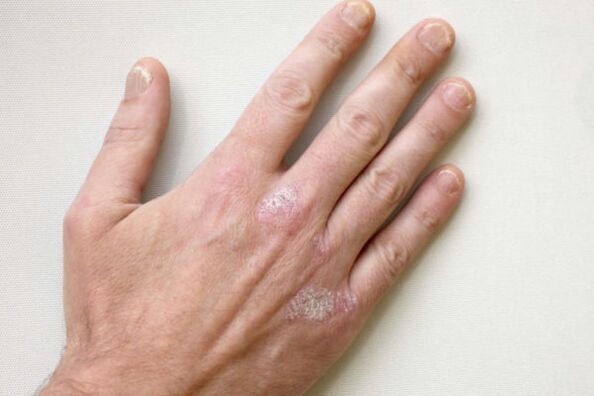
Cause and mechanism of development
Psoriasis plaques on the hands, especially on the fingers, have a significant impact on quality of life. Despite the fact that the disease is not contagious, strange skin defects are alarming. Psoriasis is not the most pleasant disease, and not only because it looks like it, but also because of the risk of complications.
The exact cause of the appearance of this dermatological disease is still unknown. Experts identify risk factors that can influence the development of pathology. It is known that psoriasis is not transmitted by contact, cannot be transmitted through contact with an infected person.
It is also important that it cannot be completely cured, therefore, throughout life, a person is forced to take supportive substances and carefully monitor the condition of the skin at different times of the year. Exacerbations frequently occur in spring and winter. Scientists include the following factors in the development of the disease:
- genetic predisposition;
- immunodeficiency, decreased protective functions of the body;
- frequent skin lesions of viral, fungal, bacterial origin;
- sharp changes in climatic conditions;
- chronic skin diseases, including birth defects;
- long-term use of certain medications, in particular, anticonvulsants, antidepressants, and steroid hormones;
- psycho-emotional overload;
- metabolic disorders in the body.
Psoriasis patches on the hands begin to appear in the small joints, between the fingers, near the phalanges. Pathological elements are more visible on the surface of the palm. It is the most difficult to treat psoriasis in such a localized form, because the hands are constantly in contact with household chemicals and other irritants.
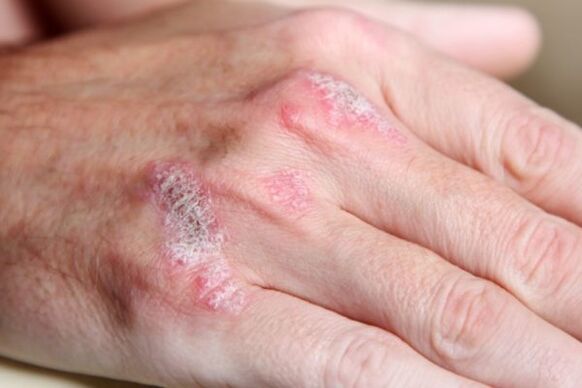
Risk group
The risk group includes both men and women who often face other dermatological diseases. The chance of getting the disease increases when someone in the family has psoriasis.
Pathology can occur in immunocompromised people, in people living in unsafe living conditions. The risk group also includes people who, due to their activities, are forced to be exposed to harsh chemicals.
Clinical Manifestations
The first signs in the early stages of the disease will be isolated pathological factors in the hand area. The rash may appear on the hands, fingers, and palms. If the nail is involved in a pathological process, there is a risk of loss of sensitivity and the appearance of tissue edema.
Increased dryness causes cracks in the palms of the hands. There are signs of thickening of the epidermis, which looks like calluses.
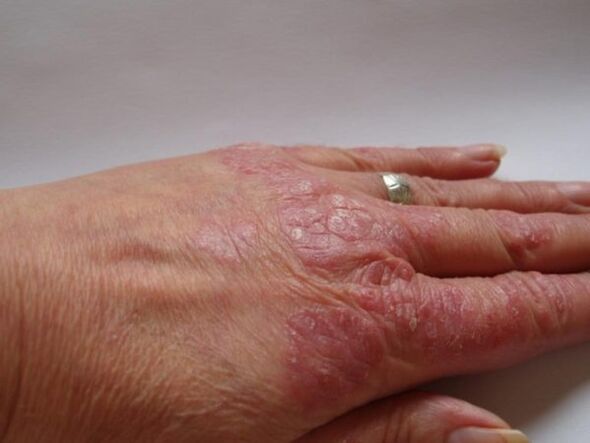
The main manifestations of psoriasis on the hands will be:
- increased dryness, pronounced redness of the skin;
- thickening of the epidermis, an increase in the volume of the fingers due to edema;
- Crack when the plaque cracks
- Sometimes a combination of several factors is harmful to healthy skin.
In winter and autumn, when cold days prevail, the disease manifests itself as intense peeling of the skin. Without treatment, there is a chance that the scratcher becomes infected, after which the symptoms are supplemented by signs of inflammation.
Types of diseases
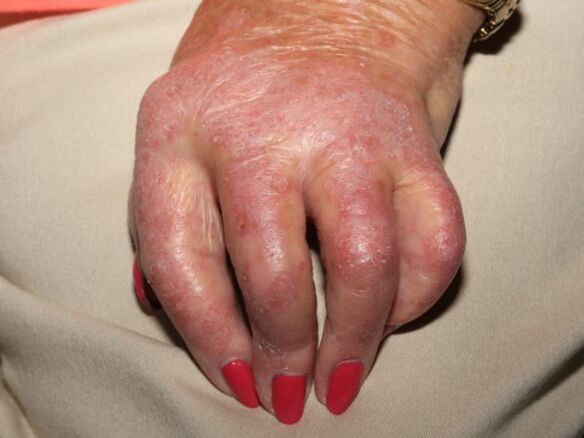
Psoriasis of the hands can take several forms:
- On the finger. It is manifested by flaking, the formation of plaques, often inflamed. Severe conditions occur in winter. It often leads to complications.
- On the brush. It occurs in 25% of patients, the signs are similar to psoriasis on the fingers, and at the same time the skin in the affected area becomes rough, areas of redness appear. Patients complain of constant discomfort, active peeling of the skin, itching.
- Palmar-plantar. Occurs in heavy manual workers. The soles of the feet and palms are affected. Rough areas of skin resemble hard calluses and very often cracks appear.
- Arthropod animals. Psoriasis occurs against the background of joint damage. The elements of the rash are located in the phalanges. In addition to the external manifestations, the patient is also worried about the pain of the joints when moving, then when resting.
- Pustules. Palms and soles are affected. Stress and hormonal pathology become risk factors. The rash is clearly demarcated, with pustules appearing. The disease often recurs and is difficult to treat completely.
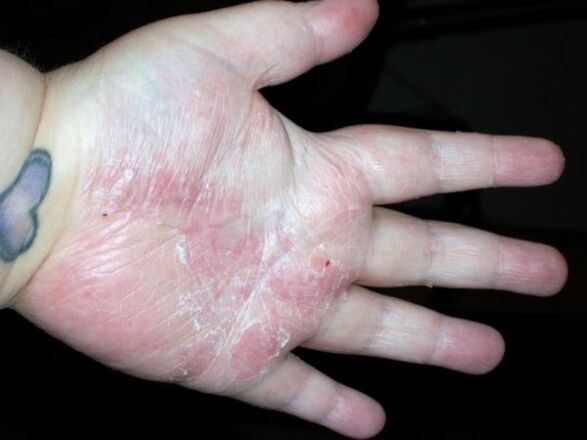
Each form of the disease progresses in three consecutive stages - initial, progressive and stopping. After a cycle (through 3 stages), the disease begins to regress. At this stage, clinical signs almost completely disappear. Treatment is aimed at prolonging the regressive phase as much as possible, otherwise the cycle of the disease repeats itself.
Differential diagnosis
Psoriasis of the hands is distinguished from such pathologies as lichenification, Reiter's disease, syphilis, seborrhea, and atopic dermatitis.
The telltale sign of psoriasis on examination will be the psoriasis triad, by its presence, the doctor can make a diagnosis. It includes stearin spots, perforation bleeding, and terminal membranes.
Treatments
Although psoriasis cannot be completely eliminated, it must be treated definitively to avoid complications and improve quality of life.
The main measures of the treatment of psoriasis on the hands:
- the use of care products to moisturize and soften the skin;
- take an antihistamine to relieve itching;
- taking drugs to increase immunity;
- additional use of homeopathic remedies.
For psoriatic lesions, physical therapy and photochemotherapy may be indicated. When psoriasis is accompanied by joint diseases, pain relievers belonging to the group of non-steroidal anti-inflammatory drugs are used.
Depending on the stage of the disease, the dermatologist will prescribe topical anti-inflammatory drugs. It can be salicylic ointment, ichthyol, sulfur-tar. For quick relief of severe itching symptoms, hormonal ointments can be used, which should not be used on your own without the permission of your doctor.
To soften and moisturize, you can use baby sensitive skin creams, which contain herbal ingredients.
Preventive measures
General precautions to prevent exacerbation of psoriasis on the hands:
- the use of rubber gloves when cleaning the house when in contact with detergents and cleaning agents;
- refuse bad habits, sleep well and balance nutrition;
- daily hand care with natural cosmetics or pharmaceutical preparations;
- regularly sunbathe, keep children at home, go for a walk in the fresh air, avoid stress;
- Treat the skin with an antiseptic in case of accidental injury (it is not recommended to bandage the wound for a long time);
- Follow the Pegano diet, which involves limiting meat and sweets and adding more grains, vegetables, and herbs to your diet.
Disease prognosis
Unpleasant psoriasis on the hands is causing stress for many people. At the same time, the experience only aggravated the situation. Psoriasis can go away for a long time, but for this disease you need to follow the treatment and prevention measures prescribed by your doctor.
It is not possible to completely get rid of psoriasis, but proper skin care, adherence to the diet and use of specific creams will hide the symptoms of the disease to the maximum. Regardless of the manifestation of the disease, it is advisable to visit a dermatologist every few months to monitor the progress of the disease and treat it according to the right regimen, if the condition requires it.

























